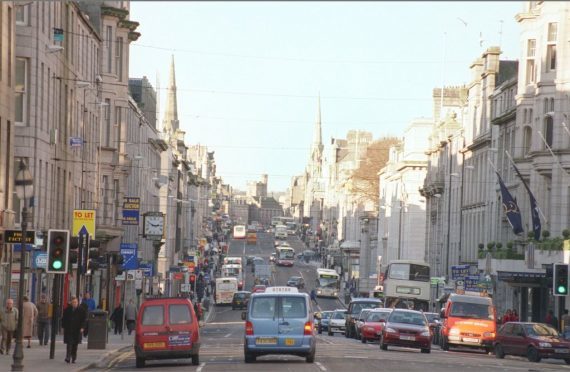Setting up a green Low Emission Zone in Aberdeen could cost up to £20million – despite the numbers of cars and lorries on city streets dropping by thousands in the past five years.
Councillors will be asked tomorrow to approve the next stage of a feasibility study into implementing the scheme in the Granite City, with a report indicating the potential cost of the scheme.
But last night critics questioned the spend at a time when council budgets are being slashed and a slew of multi-million pound traffic-busting projects are in the pipeline.
The Scottish Government has already pledged the first London-style LEZ will be established in Glasgow by the end of 2018, with the other three to follow by 2020.
Motorists would be penalised for driving into Scotland’s cities unless their vehicles have the cleanest engines, while other vehicles would be banned – with penalty levels expected to be more than £20 a day.
In January, a Friends of the Earth report revealed that Union Street, Wellington Road and King Street all rank among the most polluted in Scotland.
It is understood that these are all under consideration for LEZ.
However, the city council and Transport Scotland have already completed, or are finishing, major projects to remove the bottlenecks which cause the pollution – including the £25million Third Don Crossing, the £750million AWPR, the Haudagain bypass and Berryden Corridor.
In a report to councillors on tomorrow’s urgent business committee, it states the numbers of cars on the streets, plus Market Street, on a typical 12-hour basis have reduced by more than 6,000.
The figures for heavy goods vehicles (HGVs) and large goods vehicles (LGVs) showed reductions of more than 2,000 and 1,000 respectively.
The document says the costs of infrastructure associated with the scheme, which could include the likes of cameras and air monitors, could be as high as £20million.
It reads: “Pollution concentrations at the monitoring stations have significantly reduced over the last few years…
“Estimated costs to develop a LEZ and provide the necessary infrastructure are £10million-£20million based on studies elsewhere in the UK.”
But Neil Greig, of the IAM Roadwise drivers group, warned the proposals could “grind city centres to a halt” adding that the AWPR was likely to remove many heavy polluting vehicles.
He said: “The bypass will be very important, especially in taking away the heavy vehicles from city streets.
“This is a very surprising figure when the whole scheme is supposed to be about reducing congestion.”
Tom Mason, Conservative MSP for the north-east and also a city councillor, said: “A bill of up to £20million at a time of squeezed spending on local services seems a very high price to pay.
“The figures within this report suggest that congestion on the major arterial routes in Aberdeen has reduced over the past five years.
“It will be interesting to see what impact the new Aberdeen bypass has on the amount of HGV traffic in particular. Coupled with technological advances in car manufacturing, it could be that we see a reduction in emissions on city streets before these zones are even created.”
But council transport spokesman Ross Grant said: “Aberdeen City Council is committed to investigate how best to implement a Low Emission Zone (LEZ) that works for Aberdeen in the ongoing battle to significantly and practically tackle air pollution that continues to plague a a number of key hotspots in the city.
“Discussions with the Scottish Government are ongoing and we are in contact with the other major Scottish Cities which are also considering how they intend to implement a scheme, including Glasgow.”
